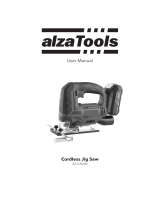
PTSS 1200 C1
■ 16
│
DE
│
AT
│
CH
1. Arbeitsplatzsicherheit
a) Halten Sie Ihren Arbeitsbereich sauber und
gut beleuchtet. Unordnung und unbeleuchtete
Arbeitsbereiche können zu Unfällen führen.
b) Arbeiten Sie mit dem Elektrowerkzeug nicht
in explosionsgefährdeter Umgebung, in der
sich brennbare Flüssigkeiten, Gase oder
Stäube befinden. Elektrowerkzeuge erzeugen
Funken, die den Staub oder die Dämpfe entzün-
den können.
c) Halten Sie Kinder und andere Personen wäh-
rend der Benutzung des Elektrowerkzeugs
fern. Bei Ablenkung können Sie die Kontrolle
über das Elektrowerkzeug verlieren.
2. Elektrische Sicherheit
a) Der Anschlussstecker des Elektrowerkzeugs
muss in die Steckdose passen. Der Stecker
darf in keiner Weise verändert werden.
Verwenden Sie keine Adapterstecker gemein-
sam mit schutzgeerdeten Elektrowerkzeugen.
Unveränderte Stecker und passende Steckdo-
sen verringern das Risiko eines elektrischen
Schlages.
b) Vermeiden Sie Körperkontakt mit geerdeten
Oberflächen wie von Rohren, Heizungen,
Herden und Kühlschränken. Es besteht ein
erhöhtes Risiko durch elektrischen Schlag, wenn
Ihr Körper geerdet ist.
c) Halten Sie Elektrowerkzeuge von Regen
oder Nässe fern. Das Eindringen von Wasser
in ein Elektrowerkzeug erhöht das Risiko eines
elektrischen Schlages.
d) Zweckentfremden Sie die Anschlussleitung
nicht, um das Elektrowerkzeug zu tragen,
aufzuhängen oder um den Stecker aus der
Steckdose zu ziehen. Halten Sie die Anschluss-
leitung fern von Hitze, Öl, scharfen Kanten
oder sich bewegenden Teilen. Beschädigte
oder verwickelte Anschlussleitungen erhöhen das
Risiko eines elektrischen Schlages.
e) Wenn Sie mit einem Elektrowerkzeug im
Freien arbeiten, verwenden Sie nur Ver-
längerungsleitungen, die auch für den
Außenbereich zugelassen sind. Die Anwen-
dung einer für den Außenbereich geeigneten
Verlängerungsleitung verringert das Risiko eines
elektrischen Schlages.
f) Wenn der Betrieb des Elektrowerkzeugs in
feuchter Umgebung nicht vermeidbar ist, ver-
wenden Sie einen Fehlerstromschutzschalter.
Der Einsatz eines Fehlerstromschutzschalters ver-
mindert das Risiko eines elektrischen Schlages.
3. Sicherheit von Personen
a) Seien Sie aufmerksam, achten Sie darauf,
was Sie tun, und gehen Sie mit Vernunft
an die Arbeit mit einem Elektrowerkzeug.
Benutzen Sie kein Elektrowerkzeug, wenn
Sie müde sind oder unter dem Einfluss von
Drogen, Alkohol oder Medikamenten stehen.
Ein Moment der Unachtsamkeit beim Gebrauch
des Elektrowerk zeugs kann zu ernsthaften
Verletzungen führen.
b) T
ragen Sie persönliche Schutzausrüstung und
immer eine Schutzbrille. Das Tragen persönlicher
Schutzausrüstung, wie Staubmaske, rutschfeste
Sicherheitsschuhe, Schutzhelm oder Gehörschutz,
je nach Art und Einsatz des Elektrowerkzeugs,
verringert das Risiko von Verletzungen.
c) Vermeiden Sie eine unbeabsichtigte
Inbetrieb nahme. Vergewissern Sie sich, dass
das Elektrowerkzeug ausgeschaltet ist, bevor
Sie es an die Stromversorgung und / oder
den Akku anschließen, es aufnehmen oder
tragen. Wenn Sie beim Tragen des Elektrowerk-
zeugs den Finger am Schalter haben oder das
Elektrowerkzeug eingeschaltet an die Strom-
versorgung anschließen, kann dies zu Unfällen
führen.
d) Entfernen Sie Einstellwerkzeuge oder Schrau-
benschlüssel, bevor Sie das Elektrowerkzeug
einschalten. Ein Werkzeug oder Schlüssel, der
sich in einem drehenden Teil des Elektrowerk-
zeugs befindet, kann zu Verletzungen führen.




















